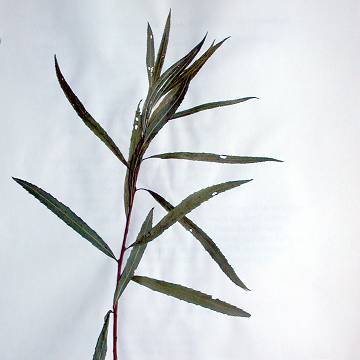

Salix interior - (image 1 of 2)
Taxonomy
Family: Salicaceae
Habitat
Common in low ground, sandbars, mudflats. Along streams and pond borders. Fallow fields.
Associates
In low ground with Acer negundo, Acer saccharum, Cicuta maculata, Eupatorium perfoliatum, Pycopus americanus, Populus deltoides, Salix nigra, Vitis riparia. On sandy beaches of Lake Michigan with Ammophila breviligulata, Artemisia caudata, Cakile edentula, Calamovilfa longifolia magna, Lathyrus japonicus glaber, Potentilla anserina, Prunus pumilla. Along pond and stream shores with Alisma subcordatum, Echinochloa crusgalli, Leersia oryzoides, Lippia lanceolata, Lycopus americanus, Lythrum alatum, Mimulus ringens, Penthorum sedoides, Scirpus atrovirens.
Distribution
Widespread east of the Rockies.
Morphology
Multi-stemmed, deciduous shrub 1.5-3 m tall, occasionally larger. Twigs slender, brown or reddish-brown, sericeous when young. Leaves alternate, the blade mostly more than 10 times as long as wide; leaf margins irregularly serrate, with more than 3 sharp or glandular teeth per cm, except occasionally towards the base; young leaves linear, with irregular teeth; petioles eglandular at the summit. Stamens mostly 2, pubescent or glabrous, the filaments loosely pubescent, at least below the middle; aments borne on short, leafy peduncles more than 2 cm long; ovaries and capsules gray-hairy to glabrescent; floral bracts pale yellowish or greenish, deciduous after anthesis, mostly more than 2 mm long.
Notes
Flowers late April to late July
Wetland indicator: Obligate
Can form huge vegetative colonies. The most common willow in northeastern IL. Cronquist considers this to be a subspecies of S. exigua Nutt., which occurs throughout the U.S., southern Canada, and northern Mexico.
References
Gleason, Henry A. and A. Cronquist. 1991. Manual of Vascular Plants of Northeastern United States and Adjacent Canada. Second Ed.
The New York Botanical Garden. Bronx, NY
Swink, F. and G. Wilhelm. 1994. Plants of the Chicago Region.
Indiana Academy of Science. The Morton Arboretum. Lisle, Illinois.
|
Michael Hough © 2005 |